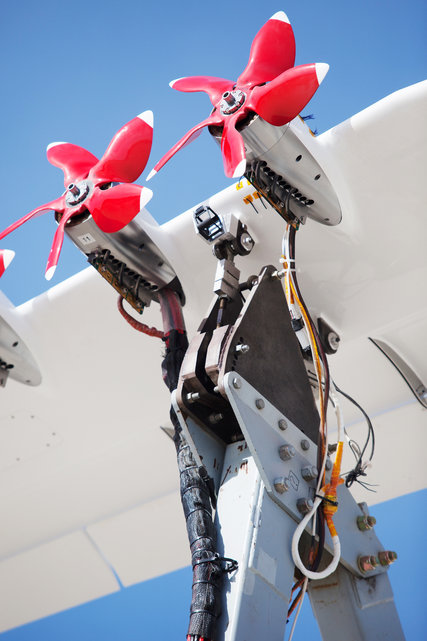Reshaping the airplane for climate reasons
The New York Times
EDWARDS AIR FORCE BASE, Calif. — It will never soar into the wild blue yonder, but the dusty Peterbilt truck parked outside a hangar at NASA’s Armstrong Flight Research Center here may represent the future of low-carbon aviation.
Perched on steel supports behind the truck’s cab is a 30-foot airplane wing, the kind found on a small plane. Instead of a fossil-fuel-burning engine or two, however, the wing is outfitted with 18 electric motors along its leading edge, each with a small red propeller.
The truck-plane mash-up, a NASA project called LeapTech, is meant to test a new approach to powering flight. Technicians and engineers have been driving the truck down a dry lake-bed runway at this desert base at more than 70 miles per hour, the battery-powered propellers spinning as if a takeoff were imminent.
“We’re able to simulate full takeoff and landing configurations and measure lift, drag, motor efficiency and aerodynamic performance,” said Sean Clarke, an engineer and a principal investigator on the project.

The concept, called distributed propulsion, is one of several being studied here and at other research centers to develop technologies that could lead to completely new and far less polluting aircraft designs. Future planes may be powered by batteries or hybrid gas-electric systems, for instance, and have lighter wings that can quickly change shape to better handle the stresses brought on by turbulent air. Others may eliminate the conventional wings-and-fuselage design in favor of one that blends the two elements, all to further the cause of lower emissions.
Commercial aviation accounts for about 2 percent of the global total of carbon dioxide emitted annually by human activity, or a little less than is produced by Germany. Although manufacturers and airlines have made air travel far more efficient — the Air Transport Action Group, an industry organization, estimates that emissions per seat-mile are down 70 percentfrom the 1960s, when jets began operating — the industry’s tremendous growth has resulted in higher total emissions.
That growth shows no signs of stopping. The International Civil Aviation Organization, the United Nations agency that oversees the industry, forecasts that the worldwide commercial fleet will double, to about 40,000 airliners, in the next 15 years. And a recent European Commission reportnoted that as countries and other industries reined in their emissions, aviation could eventually be responsible for more than one-fifth of the global total.
Although aviation was left out of the climate agreement adopted in Paris last month — that omission has some environmentalists questioning just how “historic” the accord actually was — reducing emissions remains a priority for the I.C.A.O., a spokesman said. Among other initiatives, the agency is expected to approve certification standards next year that would limit CO2 emissions for new aircraft.
In the United States, the Environmental Protection Agency earlier this year moved to begin regulating greenhouse gas emissions from aircraft, although the rule-making process is expected to be contentious and lengthy.
Because emissions are directly related to fuel consumption, and fuel accounts for one-third or more of an airline’s costs, carriers and manufacturers continue to make improvements. Planes have become lighter through the use of composite materials, like those that make up about half of the airframe of a Boeing 787. Jet engines have become more efficient. Alternative fuels, like biofuels, are starting to be used that sharply cut net carbon emissions. And operational measures like better management of airplane traffic, both at airports and in the air, have further reduced emissions.
Daniel Rutherford, who studies aircraft emissions as a program director at the International Council on Clean Transportation, a research group, said that improvements in fuel consumption, which have averaged a 1.3 percent reduction a year, should continue through the next decade.
“Efficient designs fleshed out in the ‘00s when fuel prices were high are coming to market now,” he said.
Many of the improvements involve changes to existing planes — like adding winglets to wings, which reduce drag and improve efficiency by a few percentage points, or replacing older engines with more efficient models. So-called re-engining, in fact, “has been the biggest single contributor to improving fuel efficiency over the long term,” Dr. Rutherford said.
Some aircraft have been partly redesigned. Later this decade, for example, Boeing will introduce a variant of its 777 model, the 777x, with new composite wings and more efficient engines.
Further improvements can be expected beyond the 2020s, Dr. Rutherford said, depending on how aggressively the industry adopts other advanced technologies like open-rotor engines, which improve efficiency by eliminating the shroud that surrounds most jet engines, and aerodynamic modifications that smooth the airflow over surfaces to reduce drag. (Boeing already uses such a system, referred to as hybrid laminar flow control, on the tail of its latest 787 model.)
But even with all the improvements, actual and potential, the basic design of an airplane remains the same — a tube and wings. “From a basic structure standpoint, a 787 doesn’t look a whole lot different from a 707,” said Jay E. Dryer, who directs NASA’s Advanced Air Vehicles Program.
To achieve the drastic emissions reductions that may be required by the middle of the century and beyond — to make aviation as carbon-free as possible — new “clean sheet” aircraft designs may be needed, incorporating new technologies and approaches. That’s where the Armstrong Flight Research Center comes in, developing technological concepts that manufacturers may one day use in radical new designs.
Not far from the LeapTech truck is another hangar containing a Gulfstream business jet that has been stripped bare and wired with hundreds of sensors. It is a flying technology test bed, and is testing modifications to the trailing edge of the wings. Where a flap would normally be, there is instead a continuous, bent surface, which changes the aerodynamic characteristics of the wing.
The concept is still being developed, but the eventual goal would be wings that could morph in response to real-time conditions. “The idea is to ultimately replace the entire trailing edge of an aircraft wing with technology like this, so you could continuously change the shape of the wing to reduce drag and increase lift,” said Ethan Baumann, chief engineer for the test jet. The technology could also allow the drag and lift forces to be shifted around the wings to avoid overloading, so the wings could be lighter than conventional ones.
The idea behind distributed propulsion is to take the engines from their usual position hanging below the wings and put them elsewhere. Becausee jet engines are complex, heavy devices, distributed propulsion designs almost always involve simpler and smaller electric motors.
How to submit an Op-Ed: Libyan Express accepts opinion articles on a wide range of topics. Submissions may be sent to oped@libyanexpress.com. Please include ‘Op-Ed’ in the subject line.
- Libya’s HCS invites applicants for key state roles - December 31, 2023
- UK calls on Iran to prevent escalation in Israel-Hamas conflict - November 05, 2023
- Libyan Interior Minister: Immigrant shelter costs a fortune - November 05, 2023


